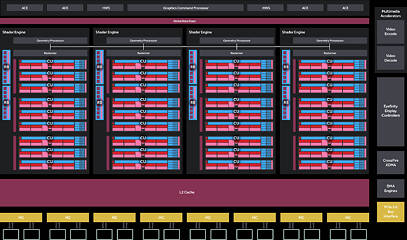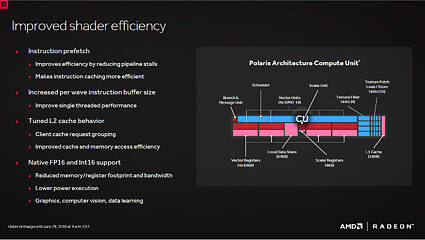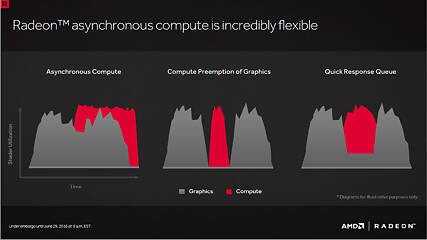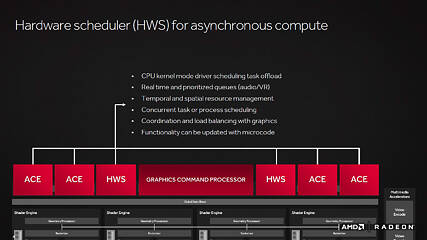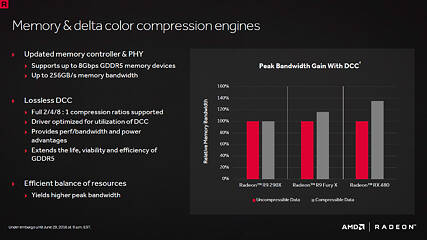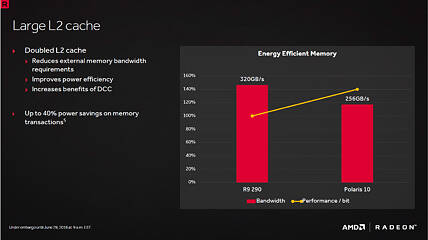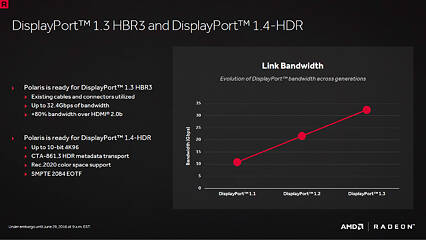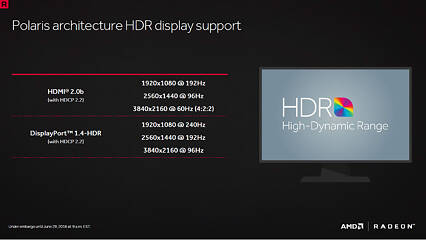 450
450
AMD Radeon RX 480 8 GB Review
The Card »Architecture
At the heart of the Radeon RX 480 is the new "Ellesmere" (Polaris 10) GPU built on the 14 nanometer silicon fab process by Samsung and GlobalFoundries. The wafers are made in Upstate New York, USA, and are then bumped and packaged at a facility in Taiwan to be sent to the various graphics card manufacturers located there and across the straits.This GPU is based on AMD's fourth generation Graphics CoreNext architecture codenamed "Polaris." According to AMD, Compute Units (CUs) based on Polaris are 15% more efficient at number-crunching than CUs based on the preceding Graphics CoreNext 1.2 architecture (R9 Fury, R9 380X). Pay attention to the numbers here. While the number-crunching machinery is 15% more efficient, the chip overall is claimed to have a 2.5x leap in energy-efficiency over the previous generation. This is because AMD is cashing in on the immediate gains a new silicon fab process brings to the table, the 14 nm FinFET process in this case, to increase transistor counts and clock speeds.
The component hierarchy in the Polaris 10 "Ellesmere" silicon is similar to older-generation chips, although each of the components received major updates. We begin with the chip featuring two hardware schedulers and the introduction of dedicated real-time asynchronous compute with spatial and temporal scheduling. The chip features four async compute engines (ACEs). AMD optimized the async compute engine with new quick-response queue tech.
There's a design focus on stepping up geometry processing performance and blunting the brute-tessellation advantage NVIDIA traditionally enjoyed over AMD. For a chip of this segment, Polaris 10 features four independent geometry processors. Their functionality is upgraded over the previous generation, featuring a primitive discard accelerator which culls (discards) triangles in the pipeline with zero area or no inclusive sample points. The geometry engine now features a tiny cache called the Index Cache, which cushions small instanced geometry and reduces data movement, improving primitive throughput during instancing.
The Polaris 10 silicon features 36 Compute Units (CUs), spread across four shader engines, each with a dedicated geometry processor, a raster engine, and two render backends. The four shader engines are supported by a large 2 MB L2 cache, which acts as the town-square for the various key components of the GPU.
Most of the architecture-specific innovations are centered on the CU, which now features a hardware instruction prefetcher, a larger instruction buffer, and native half-precision (FP16/Int16) support, which should reliably crunch numbers for gaming applications with significantly reduced memory and register footprints while lowering power execution. Altogether, the "Polaris" CU is claimed to have up to 15% higher performance than CUs based on the GCN 1.1 architecture (R9 390X). Each CU features 64 stream processors, and so the 36 CUs amount to 2,304 stream processors. The Radeon RX 480 maxes out all CUs physically present on the chip. In summary, the Polaris 10 chip features 2,304 stream processors, 144 TMUs, and 32 ROPs.
The Polaris 10 chip features a 256-bit wide GDDR5 memory interface, supporting 8 Gbps memory chips in sizes of up to 8 GB. The actual memory bandwidth of this interface, at its given clock speeds, is rated at up to 256 GB/s, although its effective bandwidth could be higher thanks to an updated lossless delta color compression (DCC) tech with full 2/4/8:1 compression ratios. AMD claims that its new gen DCC tech can provide an effective bandwidth uplift of a staggering 30 percent.
The multimedia accelerators receive a major update, now supporting H.265 Main10 decode hardware acceleration and 4K60 HEVC encode hardware acceleration. The other components with big updates are the display controllers, which now support DisplayPort 1.4 (DP 1.3 HBR3 and DP 1.4 HDR) and HDMI 2.0b. FreeSync is supported over both DP and HDMI. Resolutions as high as 5K60, 10-bit 4K96 HDR, and 4K120 SDR are supported.
Feb 22nd, 2025 00:52 EST
change timezone
Latest GPU Drivers
New Forum Posts
- revisiting hpet bcdedit tweaks: what are your timer bench results and settings? (87)
- PC Turns Off Immediately After Pressing Power Button--Must be Held Down to Power On (1)
- Modified drivers for X-Fi sound cards. (26)
- Share your AIDA 64 cache and memory benchmark here (3016)
- PBO issues on ASRock B650 PG Lightning (6)
- Is AMD Fluid Motion Frames a scam ? (6)
- Sim Racing Hardware Setups (15)
- Nvidia's GPU market share hits 90% in Q4 2024 (gets closer to full monopoly) (451)
- My broken XFX 480 8GB ”Reference” (16)
- 572.42 Drivers, Screen Blacking Out? (8)
Popular Reviews
- MSI GeForce RTX 5070 Ti Ventus 3X OC Review
- Gigabyte GeForce RTX 5090 Gaming OC Review
- Galax GeForce RTX 5070 Ti 1-Click OC White Review
- ASUS GeForce RTX 5070 Ti TUF OC Review
- Ducky One X Inductive Keyboard Review
- MSI GeForce RTX 5070 Ti Vanguard SOC Review
- MSI GeForce RTX 5070 Ti Gaming Trio OC+ Review
- MSI MAG Z890 Tomahawk Wi-Fi Review
- AMD Ryzen 7 9800X3D Review - The Best Gaming Processor
- Palit GeForce RTX 5070 Ti GameRock OC Review
Controversial News Posts
- AMD Radeon 9070 XT Rumored to Outpace RTX 5070 Ti by Almost 15% (302)
- AMD Plans Aggressive Price Competition with Radeon RX 9000 Series (269)
- NVIDIA GeForce RTX 5090 Spotted with Missing ROPs, Performance Loss Confirmed, Multiple Vendors Affected (266)
- AMD is Taking Time with Radeon RX 9000 to Optimize Software and FSR 4 (256)
- AMD Radeon RX 9070 and 9070 XT Listed On Amazon - One Buyer Snags a Unit (247)
- Edward Snowden Lashes Out at NVIDIA Over GeForce RTX 50 Pricing And Value (241)
- AMD Denies Radeon RX 9070 XT $899 USD Starting Price Point Rumors (239)
- New Leak Reveals NVIDIA RTX 5080 Is Slower Than RTX 4090 (215)
